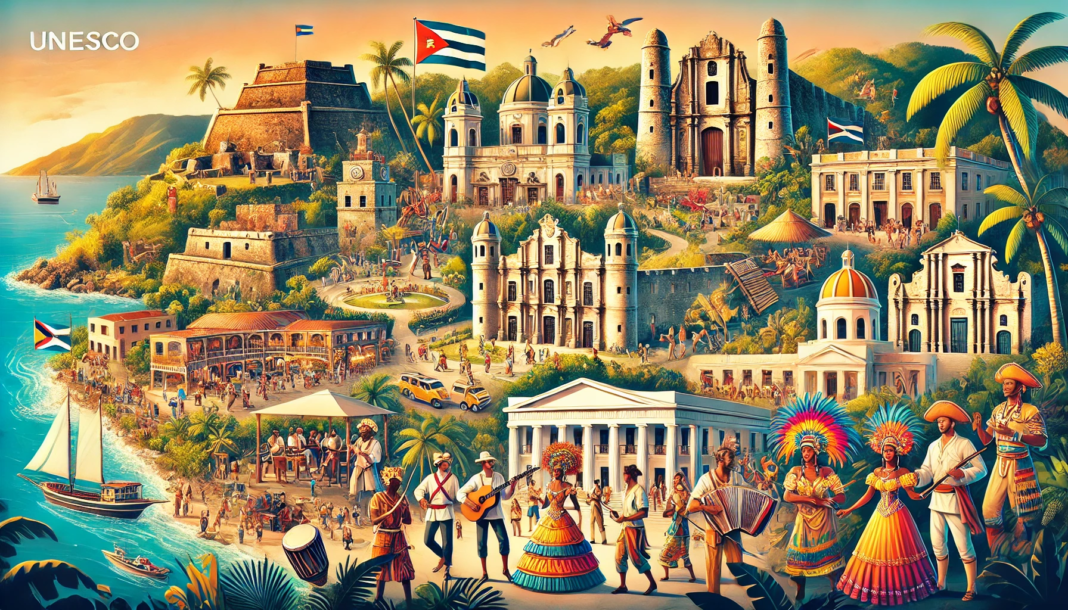The Caribbean’s UNESCO World Heritage Sites offer more than just scenic beauty and architectural grandeur; they are key to understanding the region’s cultural identity, history, and resilience. These sites reflect the fusion of indigenous, European, African, and Asian influences that have shaped the Caribbean’s societies over centuries.
From colonial fortifications and historic towns to natural landscapes that hold sacred value for indigenous peoples, each site tells a unique story of the Caribbean’s past and its cultural significance.
This guide explores the cultural importance of some of the most notable UNESCO sites in the Caribbean, highlighting how they contribute to the region’s diverse heritage.
1. Bridgetown and Its Garrison (Barbados)
Historic Bridgetown and its Garrison, inscribed as a UNESCO World Heritage Site in 2011, is a prime example of the British colonial influence in the Caribbean. The site captures the island’s strategic importance during the British Empire’s control of the Caribbean and is a testament to the island’s role in the transatlantic slave trade.
Cultural Significance:
- Colonial Architecture: Bridgetown’s architecture reflects the urban planning and military strategy of the British during the 17th to 19th centuries, with its grid-like streets, Georgian buildings, and defensive forts.
- Garrison Savannah: The garrison area was once a British military hub, and today it serves as a symbol of Barbados’ colonial past. The area also highlights the island’s movement toward independence and the transformation of these colonial structures into contemporary public spaces.
Why It Matters:
Bridgetown and its Garrison serve as a reminder of the complex colonial history of the Caribbean, particularly the impact of British rule and the island’s role in sugar production and the slave trade. It is a place where Barbadians can reflect on their history while celebrating their path to independence.
2. Old Havana and its Fortifications (Cuba)
Old Havana was declared a UNESCO World Heritage Site in 1982 and stands as a living museum of Cuba’s Spanish colonial past. As one of the Caribbean’s oldest cities, founded in 1519, Old Havana showcases the influence of Spanish architecture, urban planning, and defense strategies.
Cultural Significance:
- Spanish Colonial Architecture: The site is a masterpiece of Baroque and neoclassical architecture, with plazas, cathedrals, and mansions that tell the story of Cuba’s early settlers and its strategic importance as a port city.
- Fortifications: Havana’s fortresses, such as Castillo del Morro and Fortaleza de San Carlos de la Cabaña, were built to defend against pirate attacks and rival European powers. These military structures reflect Spain’s efforts to protect its wealth and influence in the New World.
Why It Matters:
Old Havana’s streets, buildings, and fortifications are a living reminder of Cuba’s colonial past, maritime significance, and its role in shaping the history of the Americas. The site also represents Cuba’s resilience, as Havana has evolved into a vibrant cultural hub that continues to influence Caribbean identity.
3. Morne Trois Pitons National Park (Dominica)
Located in Dominica, Morne Trois Pitons National Park was designated a UNESCO World Heritage Site in 1997 for its outstanding natural beauty and geological significance. The park’s rugged volcanic landscape is not only a natural wonder but also has cultural value for the island’s indigenous Kalinago people.
Cultural Significance:
- Sacred Landscape: For the Kalinago, Dominica’s indigenous people, the island’s mountains, rivers, and rainforests are sacred spaces, central to their spiritual beliefs and traditional practices.
- Ecological Importance: The park’s biodiversity, including rare bird species and unique volcanic features such as the Boiling Lake, reflects Dominica’s commitment to preserving its natural heritage. The park symbolizes the island’s identity as the “Nature Isle of the Caribbean.”
Why It Matters:
Morne Trois Pitons National Park represents both the natural beauty and cultural heritage of Dominica. The Kalinago’s connection to the land highlights the importance of preserving indigenous cultures and recognizing their historical ties to the Caribbean’s landscapes.
4. Brimstone Hill Fortress National Park (St. Kitts and Nevis)
The Brimstone Hill Fortress in St. Kitts is a symbol of colonial military power in the Caribbean. Built by enslaved Africans in the 17th and 18th centuries, the fortress was a critical British stronghold during the Anglo-French conflicts of the Caribbean.
Cultural Significance:
- Enslaved Labor: Brimstone Hill is a powerful reminder of the contributions of enslaved Africans who built the fortress under British colonial rule. It stands as a testament to their resilience and survival amidst harsh conditions.
- Colonial History: The fortress reflects the strategic importance of St. Kitts in the European struggle for dominance in the Caribbean. Its well-preserved structures allow visitors to learn about the role of Caribbean islands in the broader history of empire and warfare.
Why It Matters:
Brimstone Hill’s historical significance goes beyond military strategy; it is a symbol of endurance for the African descendants in the Caribbean. The site invites reflection on the colonial past and the long journey toward independence and freedom for Caribbean nations.
5. Blue and John Crow Mountains (Jamaica)
The Blue and John Crow Mountains National Park in Jamaica was inscribed as a UNESCO World Heritage Site in 2015 for its cultural and natural significance. The mountains were a refuge for the Maroons, escaped enslaved Africans who fought for their freedom against British colonial forces.
Cultural Significance:
- Maroons and Resistance: The Maroons, who escaped into the mountains in the 18th century, created their own communities, independent of colonial rule. The Blue Mountains became a symbol of resistance, as the Maroons successfully defended their freedom through guerrilla warfare.
- Natural and Cultural Heritage: The Maroon heritage in the Blue Mountains represents the spirit of self-determination and survival. The area is also a biodiversity hotspot, home to rare species and Jamaica’s famous Blue Mountain Coffee plantations.
Why It Matters:
The Blue and John Crow Mountains are emblematic of the struggle for freedom in Jamaica and across the Caribbean. The site celebrates the Maroon culture and acknowledges their contributions to Jamaica’s national identity.
6. Pitons Management Area (Saint Lucia)
The Pitons are two towering volcanic spires located on the southwest coast of Saint Lucia and are part of the Pitons Management Area, a UNESCO World Heritage Site since 2004. The Pitons have both natural and cultural significance, symbolizing the island’s volcanic origins and connection to its indigenous past.
Cultural Significance:
- Indigenous Heritage: The Pitons were once sacred to the indigenous Arawak and Carib peoples, who believed the mountains were home to powerful spirits. The cultural connection between the indigenous populations and the land still resonates today.
- Symbol of Saint Lucia: The Pitons have become a national symbol of Saint Lucian identity, featured on the country’s flag and in local folklore. The mountains also represent Saint Lucia’s commitment to preserving its natural landscapes and biodiversity.
Why It Matters:
The Pitons are not only a natural wonder but also a cultural symbol of resilience and heritage for the people of Saint Lucia. The site bridges the island’s indigenous past with its present-day identity.
7. La Fortaleza and San Juan National Historic Site (Puerto Rico)
The San Juan National Historic Site in Puerto Rico was designated a UNESCO World Heritage Site in 1983 and includes La Fortaleza, the oldest executive mansion in the Americas, and a series of colonial fortifications that once protected the island from sea invasions.
Cultural Significance:
- Spanish Colonial Legacy: The fortifications of San Juan reflect Spain’s extensive influence in the Caribbean. Built to defend the island from pirate attacks and rival European powers, these structures are some of the best-preserved examples of Spanish colonial military architecture.
- Historical Importance: As a strategic port city, San Juan played a vital role in the transatlantic trade routes and the spread of European influence in the Americas. The site offers insight into the history of conquest, trade, and defense in the Caribbean.
Why It Matters:
San Juan’s historic fortifications are a testament to Puerto Rico’s colonial past and its central role in the global dynamics of empire. The site celebrates Puerto Rico’s cultural heritage and its connection to the wider Caribbean and Latin America.
8. Willemstad, Inner City and Harbour (Curaçao)
Willemstad, the capital of Curaçao, was declared a UNESCO World Heritage Site in 1997 for its unique blend of Dutch, Spanish, and African architectural influences. The city’s colorful buildings and historic port reflect its role as a major trading hub in the Caribbean during the colonial era.
Cultural Significance:
- Multicultural Heritage: Willemstad’s architecture, with its gabled Dutch rooftops and Caribbean color palette, embodies the cultural diversity of Curaçao. The city’s history as a center for the slave trade and maritime commerce is also reflected in its layout and design.
- Cultural Fusion: The city’s urban landscape is a fusion of European colonial planning with Afro-Caribbean culture, making it a symbol of Curaçao’s multicultural identity.
Why It Matters:
Willemstad showcases the rich history of cultural exchange in the Caribbean, where European, African, and indigenous influences converged. The city is a reminder of the Caribbean’s role in global trade networks and its lasting impact on the region’s cultural development.
Conclusion
UNESCO World Heritage Sites in the Caribbean are more than just tourist attractions; they are living testaments to the region’s diverse history, resilience, and cultural richness. From ancient indigenous traditions to colonial struggles for freedom and independence, each site carries stories that have shaped the Caribbean into what it is today. By visiting and preserving these sites, we honor the heritage of the Caribbean’s peoples and ensure that future generations can connect with this unique cultural legacy.
FAQ
Why are UNESCO World Heritage Sites important for the Caribbean?
UNESCO sites in the Caribbean protect and showcase the region’s cultural and natural heritage, highlighting its historical significance and ecological diversity.
How can I visit these sites responsibly?
Visitors should follow eco-friendly and culturally sensitive tourism practices. This includes respecting local customs, supporting conservation efforts, and leaving no trace in natural sites.
What is the significance of the Maroon heritage in the Blue Mountains?
The Maroons, descendants of escaped enslaved Africans, used the Blue Mountains as a refuge and base for resistance against British colonial forces. Their culture and legacy are celebrated at the UNESCO-listed Blue and John Crow Mountains.
Are these UNESCO sites open year-round?
Yes, most of these sites are open to the public year-round, though it’s best to check for seasonal events or closures that may impact your visit.
Can I visit multiple UNESCO sites on one trip?
Yes, depending on your itinerary, you can plan to visit several UNESCO sites, especially in countries like Cuba and Puerto Rico, where multiple sites are located relatively close to each other.

